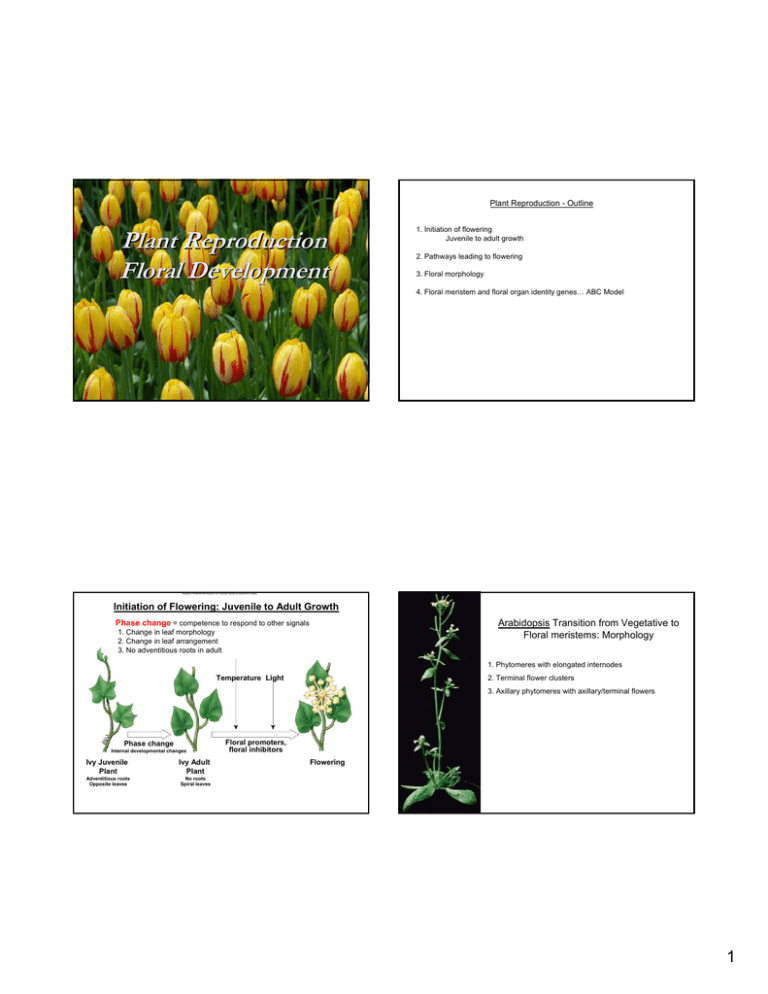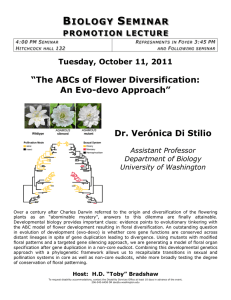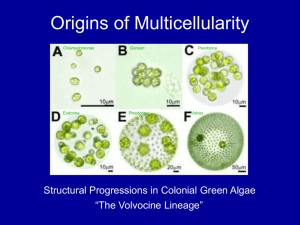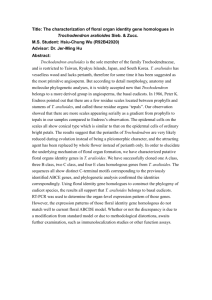Plant Reproduction Floral Development
advertisement

Plant Reproduction - Outline Plant Reproduction Floral Development 1. Initiation of flowering Juvenile to adult growth 2. Pathways leading to flowering 3. Floral morphology 4. Floral meristem and floral organ identity genes… ABC Model Copyright © The McGraw-Hill Companies, Inc. Permission required for reproduction or display. Initiation of Flowering: Juvenile to Adult Growth Fig. 41.02(TE Art) Arabidopsis Transition from Vegetative to Floral meristems: Morphology Phase change = competence to respond to other signals 1. Change in leaf morphology 2. Change in leaf arrangement 3. No adventitious roots in adult 1. Phytomeres with elongated internodes Temperature Light 2. Terminal flower clusters 3. Axillary phytomeres with axillary/terminal flowers Phase change Internal developmental changes Ivy Juvenile Plant Ivy Adult Plant Adventitious roots Opposite leaves No roots Spiral leaves Floral promoters, floral inhibitors Flowering 1 Control of Juvenile to Adult Phase Change Elements of Genetic Control – Underexpression of LEAFY gene 1. LEAFY gene of Arabidopsis required for lateral shoots to develop as flowers 2. leafy mutant created in Arabidopsis from methanesulfonate mutagenized seed. Wild type (LFY) Æ specifies flowers form from lateral meristems Control of Juvenile to Adult Phase Change Elements of Genetic Control – Overexpression of LEAFY gene Viral promoter attached to LFY gene then Inducing juvenile to adult transition. introduced in various plants… Accelerated Æ induces juvenile to adult transition. flowering LEAFY (LFY) gene required for flowering. Overexpression of gene required for flowering LEAFY (LFY) gene in Arabidopsis Æ required for transition to flower production Æ overexpressed in plant cells Æ radically shortens time to flowering leafy mutant (lfy) Æ recessive mutation Æ no flowers citrus Wild type leafy mutant Schultz, E.A. and G.W. Haughn. 1991. LEAFY, a homeotic gene that regulates inflorescence development in Arabidopsis. The Plant Cell 3: 771-781. Genetic Control of Juvenile to Adult Phase Change Transgenic plant overexpressing LEAFY gene. aspen Developmental Pathway Leading to Flowering Vegetative to Flowering (adult) phase is suppressed in wild-type plants EMF gene suppresses flower development Vegetative meristem 1) flowering is default state 2) inability to flower is the evolved state Inflorescence meristem Malformed flowers Overcoming genetic repression Arabidopsis embryonic flower mutation Æ flowers early Æ EMF wild-type gene produces protein to inhibit flowering Æ emf mutant lacks EMF protein embryonic flower mutation in Arabidopsis Floral meristems Floral organ identity genes Flower development 2 Vegetative Shoot Apex Transition from Vegetative to Inflorescence and Floral meristems in Arabidopsis Developmental/Genetic Pathway Leading to Flowering Vegetative meristem 1. Vegetative meristem Inflorescence meristem Floral meristems 2. Inflorescence and floral meristems Reproductive Shoot Apex Inflorescence meristem Floral organ identity genes A. Larger size B. Increased frequency of cell ÷ in central zone C. Floral meristems form on flanks of inflorescence meristem Flower development Floral meristems Copyright © The McGraw-Hill Companies, Inc. Permission required for reproduction or display. FLORICAULA: Floral Meristem identity gene in Snapdragon Floral Morphology Stigma Fig. 41.13(TE Art) Style Carpel Ovary (carpels = gynoecium) Anther Stamen Filament (stamens = androecium) Floricaula mutant Inflorescence, but no flowers 1. Inflorescence meristems continue to form in bract axils Wild Type Petal (petals = corolla) Receptacle Ovule Sepal (sepals = calyx) 3 Floral Organs in Arabidopsis ABC Model of Floral Organ Identity Genes and Location of their Expression 1. Initiated as whorls (rings) – – – – Sepals Petals Stamens Carpels ACTIVITY TYPES A = Field or Domain 1 B = Field or Domain 2 C = Field or Domain 3 ABC Model of Floral Organ Identity A genes: APETALA1*, APETALA2 B genes: APETALA3*, PISTILLATA* C gene: AGAMOUS* *Produce MADS box transcription factors. Floral Organ Identity Genes Vegetative Apical Meristem Inflorescence Meristem Floral Meristem Floral Organs 1. Give floral organs their identity 2. Homeotic genes: Major developmental switches produce transcription factors 3. Some are Cadastral genes – boundary genes that mutually repress each other Homeotic gene expression in Drosophila Cadastral genes 4 Homeotic transcription factors have a MADS domain structure Homeotic floral organ gene mutations: pistillata2 Homeotic Transcription factor Æ protein Founding gene family Æ from several species Yeast Snapdragons Arabidopsis People MCM1 AGAMOUS DEFICIENS SRF Movie Wild Type Flower MADS box genes 1)Highly conserved 2) produce proteins Æ Homeotic transcription factors Æ MADS domain structure pistillata mutant Carpels not Stamens Sepals not petals No petals No stamens Wild type MADS box genes Interpretation of Homeotic mutants with the ABC model: pistillata mutation pistillata mutant Homeotic floral organ gene mutations: agamous pistillata mutation B domain gene not functional 1. No stamens 2. No carpels 3. Whorls of petals or sepals 5 Interpretation of Homeotic mutants with the ABC model: agamous mutation Quadruple Mutant in Arabidopsis Flowers What’s the phenotype of a ap1, ap2, pi, ag mutant flower? agamous mutant 1.No sepals 2.No petals 3.No stamens 4.No carpels C not functional Floral Organ Identity Genes 5.All Leaf-like appendages END Floral Development 1. Give floral organs their identity • Determine location at which specific floral organs develop 2. Major developmental switches • • Originally determined through homeotic mutations Mutations: Floral organs appeared in the wrong place 3. Encode transcription factors • Belong to class of related DNA sequences having MADS box gene domains encode protein structures known as MADS domains. 4. Three classes: A, B & C 6



